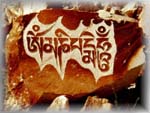
The meaning of 'Om mani padme hum'
revision18 Mar 2001
http://www.greenkiwi.co.nz/footprints/frames/om_mani...htm
Having problems printing
this page?
the Tibetan mantra

The meaning of 'Om mani padme hum'
There are many differing expert interpretations of this common mantra. A full discussion here is not appropriate given the complexity of the issues and the lack of expertise of this editor. However, anyone who travels in Tibet with an enquiring mind must wonder about the significance of ‘Om mani.....’ which is on every lip, numberless prayer flags and countless 'mani' stones.
Waddell suggests "Om! the Jewel in the Lotus! Hum!" ,an invocation for protection addressed to the great Boddhisattva of Compassion and protector of Tibet, Padmapani. He is supported in this general assessment by Snellgrove, writing a hundred years later.
Padmapani, or Pawa Chenrezig, has varying names in different Buddhist lands; Avalokiteshvara in the original Sanskri; Chenrezig in Tibetan; and Kannon in Japanese.
Avalokiteshvara took a vow to save all beings from suffering. The magnitude of this task inspires his frequent depiction in statues and paintings as a being with numerous heads, and thousands of arms.
Boddhisattavas are regarded as fully enlightened beings who choose to remain on earth to assist humanity. Throughout Tibet, and in many Buddhist lands they, and the historical Buddha, Shakamuni are worshipped as deities. That worship 'per se' is in direct conflict with original Buddhist teaching seems certain. For example, King Milinda expressed his doubts about worshipping the dead Buddha in a question to the monk Nagasena:
If he be entirely passed away, unattached to the world, escaped from all existence, then honours would not be offered to him.Such teachings, however worthy, are not easy to accept. So throughout Tibet, prayers to externalised deities are part of everday practice and the source of much effort to construct and decorate temples and monuments. We should be thankful that this piety has created objects of great beauty; that they create opportunity for reflection; and are objects which enhance not only the spiritual and physical environment of Tibet, but that of all mankind.The human psyche seems much more comfortable seeking assistance from without, than it does to recognise that Buddha and Buddha-hood lies within.
Lama Govinda offers another interpretation of the "Om mani padme hum! mantra which sits more comfortably with fundamental Buddhist teaching.
Just as the lotus grows up from the darkness of the mud to the surface of the water, opening it blossom only after it has raised itself beyond the surface, and remaining unsullied from both earth and water, which nourished it -
- in the same way the mind, born in the human body, unfolds its true qualities ("petals") after it has raised itself beyond the turbid floods of passions and ignorance, and transforms the dark powers of the depths into the radiantly pure nectar of Enlightenment-consciousness (bodhicitta), the incomparable jewel (mani) in the lotus blossom (padma).
Thus the saint grows beyond this world and surpasses it. Though his roots are in the dark depths of this world, his head is raised into the fullness of light. He is the living synthesis of the deepest and the highest, of darkness and light, the material and the immaterial, the limitations of individuality and the boundlessness of universality, the formed and the formless, Samsara and Nirvana. Nagarjuna, therefore, said of the perfectly Enlightened One: "Neither being nor not-being can be attributed to the Enlightened One. The Holy One is beyond all opposites."
Anagarika Govinda, (Lama Govinda)Therefore, the mani stone and images of Avaloketishvara can be regarded as signposts. A mirror to reflect on the compassionate aspect of our own Buddha nature.
press your 'back' or 'return' button to continue
or return to the site page from which this account originates.
top of page site map contact us
Copyright © Footprints Tours Ltd
Programming & design by Green Kiwi Ltd
Last updated: 18 Mar, 2001